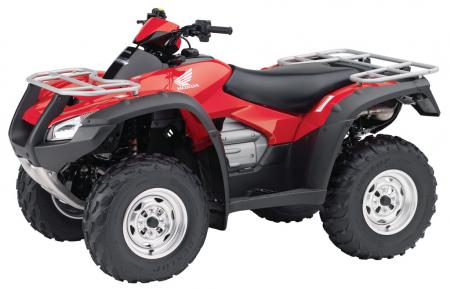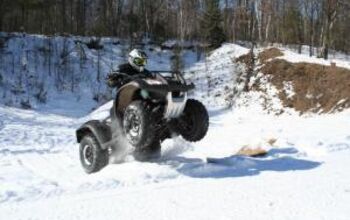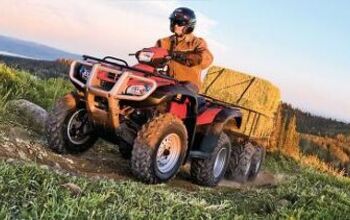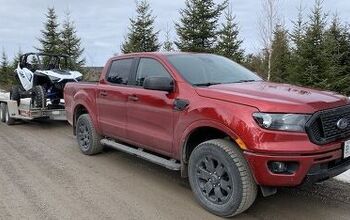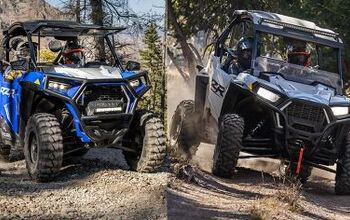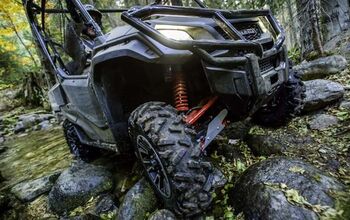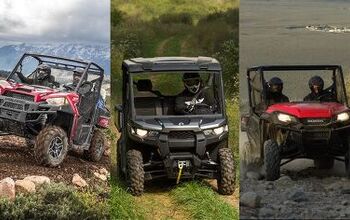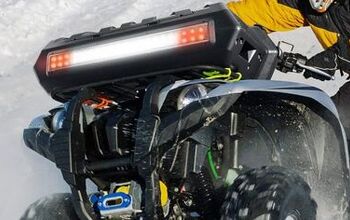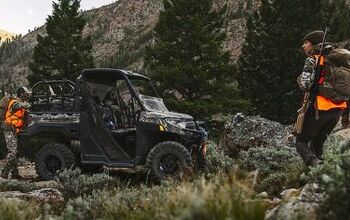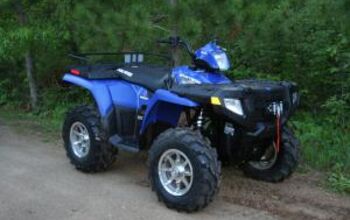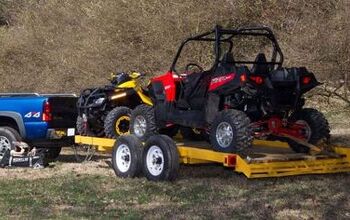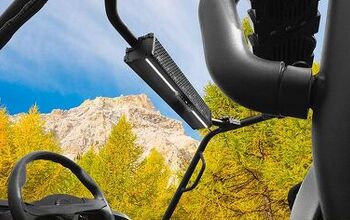2010 Honda FourTrax Rincon Review
We’ve ridden the Honda FourTrax Rincon 4×4 in several different settings and most recently in Moab, Utah, or what some call the off-road capital of the world. Although we stuck mostly to the La Sal Mountains and didn’t ride on the famous red rock formations, we still scored plenty of seat time on Honda’s flagship utility quad and learned more about its functions, makeup and abilities.
We rode a mix of trails from dry, dusty hard-pack climbs and descents with tight turns and off-camber water bars and rain ruts to full-throttle straightaways. At this elevation and in this terrain, we put the Honda’s electronic fuel injection, suspension and power to the test. We even found some snow and rocky sections to challenge the machine’s 4×4 skills.
Here’s a closer look at the 2010 Honda Rincon 4×4 as tested by ATV.com.
2010 Honda FourTrax Rincon
New For 2010
Not much has changed on the Rincon. Honda is probably one of the most conservative ATV manufacturers and lives by the doctrine “If it isn’t broke, don’t fix it.” However, that slogan should not be seen as a negative. Honda did make a few minor adjustments for 2010:
Engine/Drivetrain
Honda’s Electric Shift Program allows you to manually shift gears – a feature we especially like while descending steep hills.
The single-cylinder 675cc four-stroke engine sits longitudinally in the Rincon’s steel chassis and claims to provide a more direct and efficient transfer of power to the ground. The liquid-cooled mill also features a dry-sump and overhead valve design that Honda says contributes to the Rincon’s low center of gravity and suitable ground clearance.
The engine is mated to an industry exclusive hydraulic torque converter, not a belt-driven automatic CVT (like its competitors), which also features a three-gear Electronic Shift Program (ESP). This just means you can ride the ATV as an automatic (gas and go) or shift through three forward gears and reverse with your left thumb. While we love the convenience of an automatic transmission, we often use the ESP so we can control the Honda’s torque, revs and shifts. The ESP mode works really well for controlling speeds while descending hills.
The automotive-style drive shifter on the Rincon is neither great nor terrible. However, its location is nice. It’s tucked up under the handlebars on the left side out of the way of our left knee and optional tank bag accessories. It also has a very discreet configuration, cleaner look and is not big, bulky or easy to bump like some drive levers.
Though not as arm-stretching as many of the big bore ATVs from other manufacturers, the Rincon does produce good, predictable power.
Overall, the Rincon’s power is best described as good but not thrilling and both predictable and controllable. Fed by an electronic fuel injection (a model year 2006, second generation engineering upgrade) and 40mm Mikuni throttle bodies, it’s also responsive and much better at cold starting than the non-EFI Hondas we’ve tested in the past. We found the thumb throttle to be quick to respond when stabbed and somewhat sporty in its feel and performance, especially in ESP. However, the automatic mode sometimes feels slow to downshift or upshift for sporty riding.
We especially enjoyed the Honda’s throttle in the slow-paced rocks, when throttle control and smoothness are everything. Once we cleared the tricky spots, we just blipped our way through and over the smaller rocks. At upper elevations, however, the Rincon’s torque seems to be less impressive, but remains capable.
Another positive feature on the Rincon is its selectable Traxlok front differential switch. Conveniently located on the right side of the handlebars, the device is easy to read and simplifies shifting from two-wheel-drive to 4×4 and back again. However, there isn’t a full front differential lock setting. Therefore the Honda doesn’t use all four wheels to pull it through and over obstacles, but a limited-slip front differential design. If the machine took on any upgrade, we would love to see it receive full diff. lock, which seems to be an industry standard for this class of vehicle and another boost in displacement (Read: True 700cc power).
Suspension/Chassis/Braking
Fully independent suspension offers 10 inches of ground clearance, but the shocks lack preload adjustability.
A fully independent suspension, which provides 10 inches of ground clearance, is bolted to the Rincon’s frame and should be considered Honda’s top utility suspension for its comfort, abilities and design. Up front, the Rincon wears what Honda calls a double-wishbone configuration with twin shocks. Sadly, the shocks are non adjustable for preload. While the front shocks are adept at smoothing mildly rough trails and stay true for hard cornering, heavy loads and heavy riders can burden them. Regardless, their 6.9 inches of travel soaks up most trail obstacles and offers a mostly comfortable ride. On the rear, the Rincon’s fully independent design incorporates an anti-sway bar, two non-adjustable single-tube gas-charged shocks and a more forgiving 8 inches of travel. The rear system also has forged-aluminum knuckles and upper and lower A-arms to reduce unsprung weight. Honda also says the Rincon’s handling is improved by the use of metal bushings – not ball joints and radius arms — in the rear knuckle pivots.
While the Honda suspension may not be the best in its class for ground clearance, suspension travel or overall handling, it’s capable and confidence inspiring. This simply means it’s comfortable on technical terrain or at high speeds. The ride is nimble, has a low center of gravity (34.5-inch seat height) and is sporty in nature. These features may be the direct result of the Rincon’s lighter weight, overall size and friendly and familiar ergonomics. The suspension is not overly plush or too stiff, but would benefit from more tweaks. The front end gives off a bit of roll in aggressive cornering, but the stock 25-inch tires’ sidewall is probably to blame more than the front shocks.
The Rincon’s lighter weight and low center of gravity help provide a nimble feel.
We like the Honda’s brake lever design, feel, size and placement on the handlebars. It’s also nice to find individual front and rear levers (as opposed to a single-lever design). To stop or slow the Rincon, riders can choose the front hand brakes or rear foot brake (on right floorboard), which seems ideal for both aggressive and casual riders. Plus, we’ve always liked this configuration for climbing and descending hills or playing in technical terrain. Honda says it located the rear hydraulic disc brake and self-adjusting mechanical rear parking brake on the rear driveshaft (not out at the rear wheels) to further reduce unsprung weight and improve ground clearance. The Honda brakes work, but they aren’t class leading in terms of responsiveness or stopping power.
In terms of wheels and tires, the Rincon is average. While we like the stock aluminum wheels for their lightweight and sturdy makeup, they are rather drab for a machine of this caliber. We’d like to see Honda step up to a more versatile and sturdier radial tire, too. The stock rubber is fine for most uses but can be overmatched in certain terrain.
Ergonomics & Miscellaneous
Aside from a small feel and short handlebars for larger riders, the Rincon is almost perfect in the ergonomics department. Clearly, it has a big-bore ATV feel, but doesn’t feel as heavy (648-pound curb weight) or as large as some of the other 700cc machines in it competes with. Unlike some ATVs in its class, however, the Honda seems to avoid any annoying characteristics. Everything feels so recognizable with the Rincon — aside from the ESP for unfamiliar riders — that most people will be happy to get on, fire it up and go riding.
In typical Honda fashion, the Rincon’s ergonomics are spot on.
In terms of work, the Rincon is a very capable yet conservative machine. Although it could haul more and pull more, this Honda has some of the most modest work numbers in the full-size ATV ranks. It can tote 66 pounds on its tiny front rack and 132 on the larger rear rack. When equipped with the optional tow hitch, the Rincon can also pull up to 850 pounds.
A 12-volt waterproof accessory outlet and informative LCD are welcome conveniences.
Although the machine’s midsection can feel wide at times, it’s not the fattest big-bore quad in that area or the skinniest. We also appreciate the slight tank contour that let us tuck our knees in and hug the tank during tight cornering. The floorboards are rather roomy and feature a nice raised foot peg and holes to channel water and dirt. The seat, with its narrow front and wide rear section, would only be improved by having a little more length. We’d like to see the addition of a front and rear bumper to beef up the Rincon’s appearance and appeal, but also understand the machine’s current integrated look is more refined and automotive in appearance.
We love the little things and the Rincon has quite a few. Those convenience items include a 12-volt waterproof accessory outlet, high-tech LCD, washable foam air filter and auxiliary pull start. One key component that no longer can be found on the Rincon, however, is the GPScape (or integrated GPS). We’re OK with that and we’ll assume many owners would rather take a portable GPS with them on their trail ride anyway.
Conclusion
It’s almost too hard to believe that the Rincon comes from Honda, a company with such a stellar powersports resume and reputation. The company boasts about its ATV industry longevity, unmatched reliability and racing heritage, yet its flagship Rincon 4×4 feels the least powerful and rather average compared to the current big-bore ATVs in its class. Remember, Honda puts out the TRX450R and TRX700XX, so it knows how to be aggressive. However, on the utility front, Honda appears to rely more on its specific engineering attributes and customer loyalty than it does overall class-leading performance and features. With that being said, the Rincon has a proven track record, possess several unique features and is more than capable of dependable work and sporty play (yes, it can be done). The vast majority of buyers would be pleased with the Rincon’s look, feel and abilities. Oh and let’s not forget about its reliability.
It might not be able to keep up with the 850-950cc crowd, but the Rincon is a reliable, easy-to-ride ATV that offers plenty of fun.
| Grading the 2010 Honda Rincon | |
| Positives | Negatives |
| • Ease of steering | • Lacks front differential lock |
| • Engineering-wonder-of-a transmission | • Limited onboard storage |
| • Legendary reliability | • Arguably ho-hum in appearance |
| • Proven platform | • Not the most muscular or performance oriented |
| • Smaller feel with sporty attitude | |
| • No more GPScape (wasn’t portable anyway) | |
Comparable Vehicles: Arctic Cat 700 H1 EFI, Can-Am Outlander 650 EFI, Kawasaki Brute Force 750 4x4i, Polaris Sportsman 850 XP, Suzuki KingQuad 750 AXi 4×4, Yamaha Grizzly 700 FI Auto 4×4
Related Reading
More by ATV.com Staff



